A Report on the Role of miRNA in the Warburg Effect and Cancer Biology
VerifiedAdded on 2022/12/18
|12
|2750
|42
Report
AI Summary
This report delves into the intricate relationship between microRNAs (miRNAs) and the Warburg effect, a hallmark of cancer cell metabolism. It begins with an introduction to glucose homeostasis and the key roles of insulin and glucagon in regulating blood glucose levels. The report then explores the Warburg effect, where cancer cells exhibit increased glucose uptake and glycolysis even in the presence of oxygen, and highlights the regulatory function of miRNAs in this process. It examines how miRNAs influence glucose transport, glycolytic enzyme expression, and overall cancer cell proliferation. The study also touches upon the potential of miRNAs as therapeutic agents, emphasizing their ability to modulate gene expression and potentially suppress cancer cell growth. The report concludes by underscoring the need for further research to fully understand the complex mechanisms of miRNA in cancer and develop effective therapeutic strategies. The report provides a comprehensive overview of the current understanding of the role of miRNA in the Warburg effect and its implications for cancer biology.

Molecular Cell Biology
Paraphrase This Document
Need a fresh take? Get an instant paraphrase of this document with our AI Paraphraser
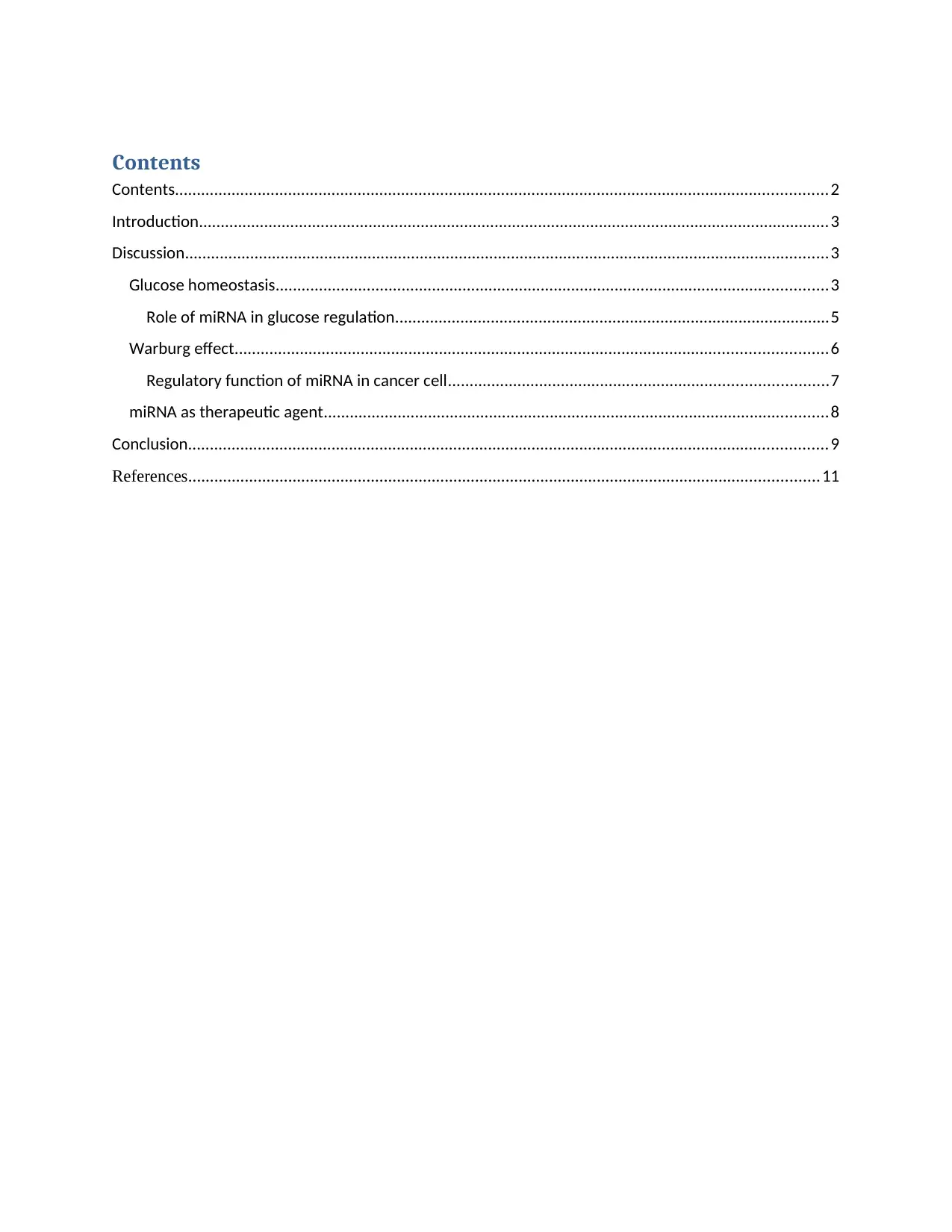
Contents
Contents......................................................................................................................................................2
Introduction.................................................................................................................................................3
Discussion....................................................................................................................................................3
Glucose homeostasis...............................................................................................................................3
Role of miRNA in glucose regulation....................................................................................................5
Warburg effect........................................................................................................................................6
Regulatory function of miRNA in cancer cell.......................................................................................7
miRNA as therapeutic agent....................................................................................................................8
Conclusion...................................................................................................................................................9
References.................................................................................................................................................11
Contents......................................................................................................................................................2
Introduction.................................................................................................................................................3
Discussion....................................................................................................................................................3
Glucose homeostasis...............................................................................................................................3
Role of miRNA in glucose regulation....................................................................................................5
Warburg effect........................................................................................................................................6
Regulatory function of miRNA in cancer cell.......................................................................................7
miRNA as therapeutic agent....................................................................................................................8
Conclusion...................................................................................................................................................9
References.................................................................................................................................................11
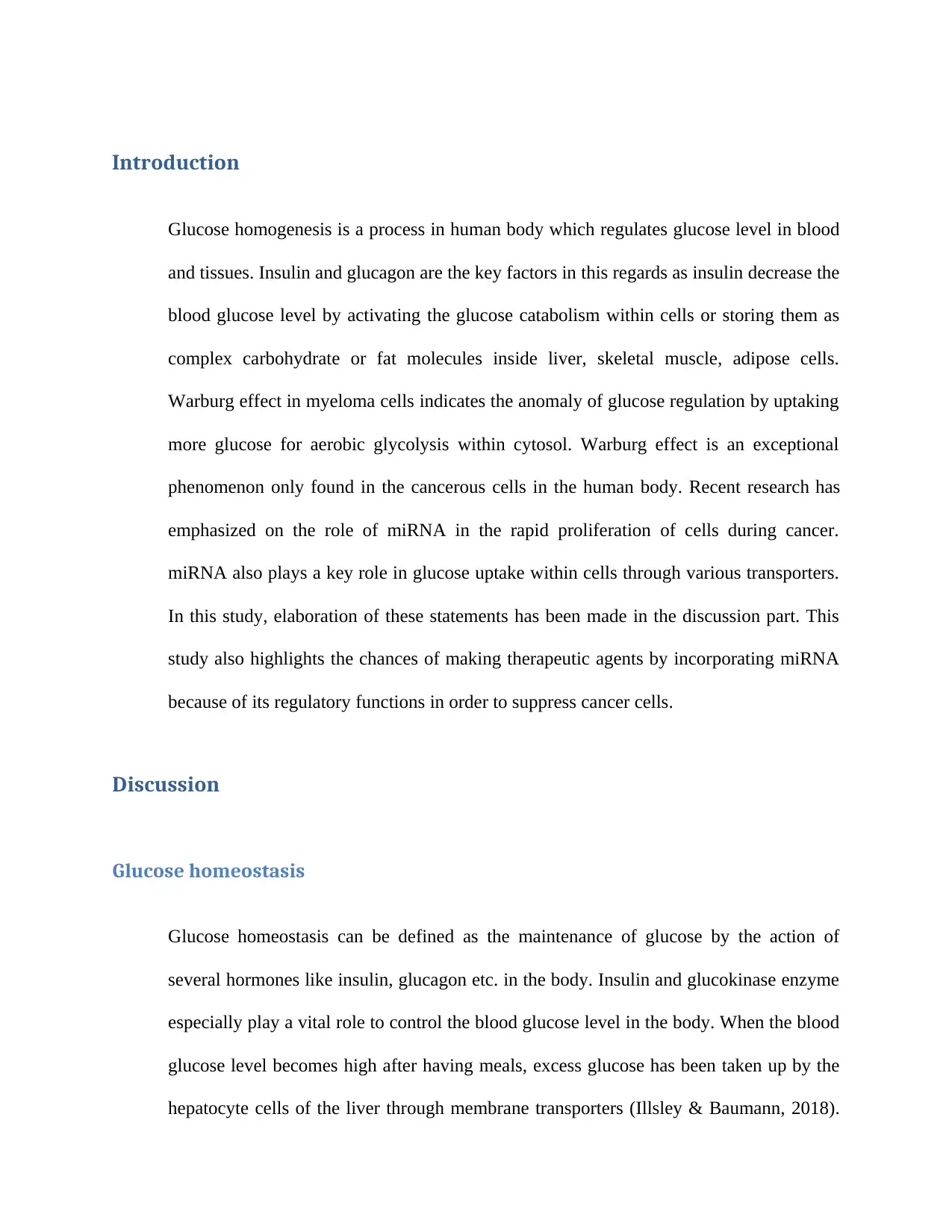
Introduction
Glucose homogenesis is a process in human body which regulates glucose level in blood
and tissues. Insulin and glucagon are the key factors in this regards as insulin decrease the
blood glucose level by activating the glucose catabolism within cells or storing them as
complex carbohydrate or fat molecules inside liver, skeletal muscle, adipose cells.
Warburg effect in myeloma cells indicates the anomaly of glucose regulation by uptaking
more glucose for aerobic glycolysis within cytosol. Warburg effect is an exceptional
phenomenon only found in the cancerous cells in the human body. Recent research has
emphasized on the role of miRNA in the rapid proliferation of cells during cancer.
miRNA also plays a key role in glucose uptake within cells through various transporters.
In this study, elaboration of these statements has been made in the discussion part. This
study also highlights the chances of making therapeutic agents by incorporating miRNA
because of its regulatory functions in order to suppress cancer cells.
Discussion
Glucose homeostasis
Glucose homeostasis can be defined as the maintenance of glucose by the action of
several hormones like insulin, glucagon etc. in the body. Insulin and glucokinase enzyme
especially play a vital role to control the blood glucose level in the body. When the blood
glucose level becomes high after having meals, excess glucose has been taken up by the
hepatocyte cells of the liver through membrane transporters (Illsley & Baumann, 2018).
Glucose homogenesis is a process in human body which regulates glucose level in blood
and tissues. Insulin and glucagon are the key factors in this regards as insulin decrease the
blood glucose level by activating the glucose catabolism within cells or storing them as
complex carbohydrate or fat molecules inside liver, skeletal muscle, adipose cells.
Warburg effect in myeloma cells indicates the anomaly of glucose regulation by uptaking
more glucose for aerobic glycolysis within cytosol. Warburg effect is an exceptional
phenomenon only found in the cancerous cells in the human body. Recent research has
emphasized on the role of miRNA in the rapid proliferation of cells during cancer.
miRNA also plays a key role in glucose uptake within cells through various transporters.
In this study, elaboration of these statements has been made in the discussion part. This
study also highlights the chances of making therapeutic agents by incorporating miRNA
because of its regulatory functions in order to suppress cancer cells.
Discussion
Glucose homeostasis
Glucose homeostasis can be defined as the maintenance of glucose by the action of
several hormones like insulin, glucagon etc. in the body. Insulin and glucokinase enzyme
especially play a vital role to control the blood glucose level in the body. When the blood
glucose level becomes high after having meals, excess glucose has been taken up by the
hepatocyte cells of the liver through membrane transporters (Illsley & Baumann, 2018).
⊘ This is a preview!⊘
Do you want full access?
Subscribe today to unlock all pages.

Trusted by 1+ million students worldwide
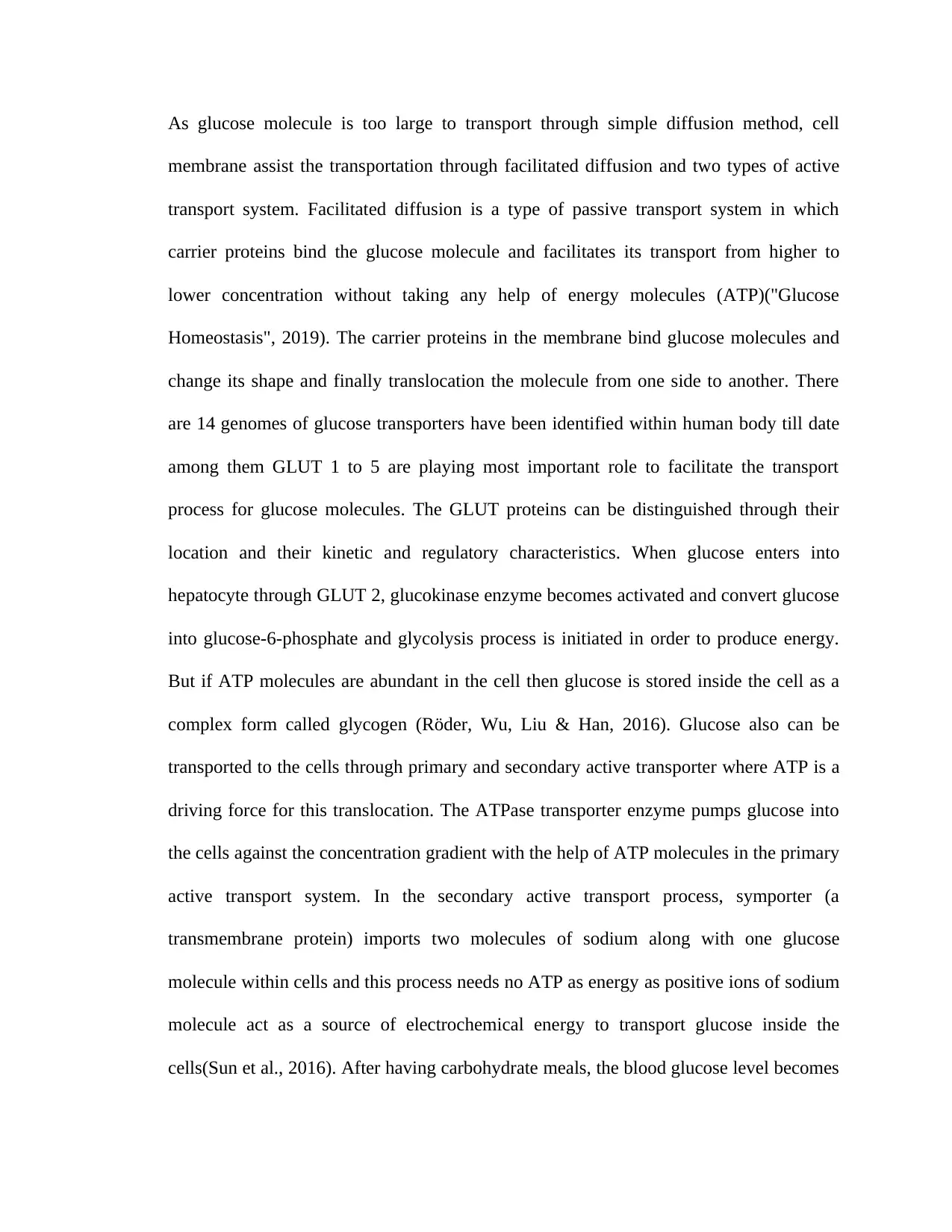
As glucose molecule is too large to transport through simple diffusion method, cell
membrane assist the transportation through facilitated diffusion and two types of active
transport system. Facilitated diffusion is a type of passive transport system in which
carrier proteins bind the glucose molecule and facilitates its transport from higher to
lower concentration without taking any help of energy molecules (ATP)("Glucose
Homeostasis", 2019). The carrier proteins in the membrane bind glucose molecules and
change its shape and finally translocation the molecule from one side to another. There
are 14 genomes of glucose transporters have been identified within human body till date
among them GLUT 1 to 5 are playing most important role to facilitate the transport
process for glucose molecules. The GLUT proteins can be distinguished through their
location and their kinetic and regulatory characteristics. When glucose enters into
hepatocyte through GLUT 2, glucokinase enzyme becomes activated and convert glucose
into glucose-6-phosphate and glycolysis process is initiated in order to produce energy.
But if ATP molecules are abundant in the cell then glucose is stored inside the cell as a
complex form called glycogen (Röder, Wu, Liu & Han, 2016). Glucose also can be
transported to the cells through primary and secondary active transporter where ATP is a
driving force for this translocation. The ATPase transporter enzyme pumps glucose into
the cells against the concentration gradient with the help of ATP molecules in the primary
active transport system. In the secondary active transport process, symporter (a
transmembrane protein) imports two molecules of sodium along with one glucose
molecule within cells and this process needs no ATP as energy as positive ions of sodium
molecule act as a source of electrochemical energy to transport glucose inside the
cells(Sun et al., 2016). After having carbohydrate meals, the blood glucose level becomes
membrane assist the transportation through facilitated diffusion and two types of active
transport system. Facilitated diffusion is a type of passive transport system in which
carrier proteins bind the glucose molecule and facilitates its transport from higher to
lower concentration without taking any help of energy molecules (ATP)("Glucose
Homeostasis", 2019). The carrier proteins in the membrane bind glucose molecules and
change its shape and finally translocation the molecule from one side to another. There
are 14 genomes of glucose transporters have been identified within human body till date
among them GLUT 1 to 5 are playing most important role to facilitate the transport
process for glucose molecules. The GLUT proteins can be distinguished through their
location and their kinetic and regulatory characteristics. When glucose enters into
hepatocyte through GLUT 2, glucokinase enzyme becomes activated and convert glucose
into glucose-6-phosphate and glycolysis process is initiated in order to produce energy.
But if ATP molecules are abundant in the cell then glucose is stored inside the cell as a
complex form called glycogen (Röder, Wu, Liu & Han, 2016). Glucose also can be
transported to the cells through primary and secondary active transporter where ATP is a
driving force for this translocation. The ATPase transporter enzyme pumps glucose into
the cells against the concentration gradient with the help of ATP molecules in the primary
active transport system. In the secondary active transport process, symporter (a
transmembrane protein) imports two molecules of sodium along with one glucose
molecule within cells and this process needs no ATP as energy as positive ions of sodium
molecule act as a source of electrochemical energy to transport glucose inside the
cells(Sun et al., 2016). After having carbohydrate meals, the blood glucose level becomes
Paraphrase This Document
Need a fresh take? Get an instant paraphrase of this document with our AI Paraphraser
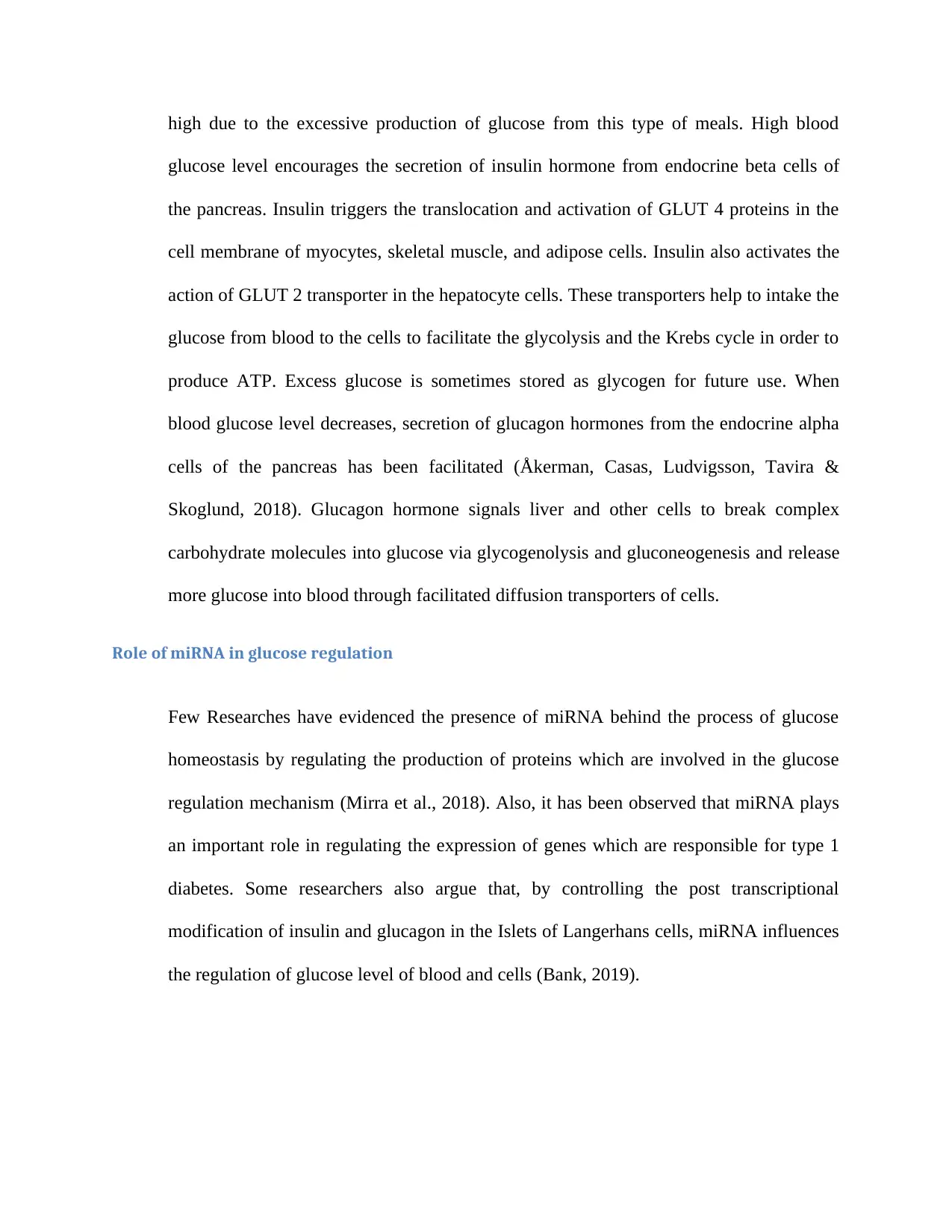
high due to the excessive production of glucose from this type of meals. High blood
glucose level encourages the secretion of insulin hormone from endocrine beta cells of
the pancreas. Insulin triggers the translocation and activation of GLUT 4 proteins in the
cell membrane of myocytes, skeletal muscle, and adipose cells. Insulin also activates the
action of GLUT 2 transporter in the hepatocyte cells. These transporters help to intake the
glucose from blood to the cells to facilitate the glycolysis and the Krebs cycle in order to
produce ATP. Excess glucose is sometimes stored as glycogen for future use. When
blood glucose level decreases, secretion of glucagon hormones from the endocrine alpha
cells of the pancreas has been facilitated (Åkerman, Casas, Ludvigsson, Tavira &
Skoglund, 2018). Glucagon hormone signals liver and other cells to break complex
carbohydrate molecules into glucose via glycogenolysis and gluconeogenesis and release
more glucose into blood through facilitated diffusion transporters of cells.
Role of miRNA in glucose regulation
Few Researches have evidenced the presence of miRNA behind the process of glucose
homeostasis by regulating the production of proteins which are involved in the glucose
regulation mechanism (Mirra et al., 2018). Also, it has been observed that miRNA plays
an important role in regulating the expression of genes which are responsible for type 1
diabetes. Some researchers also argue that, by controlling the post transcriptional
modification of insulin and glucagon in the Islets of Langerhans cells, miRNA influences
the regulation of glucose level of blood and cells (Bank, 2019).
glucose level encourages the secretion of insulin hormone from endocrine beta cells of
the pancreas. Insulin triggers the translocation and activation of GLUT 4 proteins in the
cell membrane of myocytes, skeletal muscle, and adipose cells. Insulin also activates the
action of GLUT 2 transporter in the hepatocyte cells. These transporters help to intake the
glucose from blood to the cells to facilitate the glycolysis and the Krebs cycle in order to
produce ATP. Excess glucose is sometimes stored as glycogen for future use. When
blood glucose level decreases, secretion of glucagon hormones from the endocrine alpha
cells of the pancreas has been facilitated (Åkerman, Casas, Ludvigsson, Tavira &
Skoglund, 2018). Glucagon hormone signals liver and other cells to break complex
carbohydrate molecules into glucose via glycogenolysis and gluconeogenesis and release
more glucose into blood through facilitated diffusion transporters of cells.
Role of miRNA in glucose regulation
Few Researches have evidenced the presence of miRNA behind the process of glucose
homeostasis by regulating the production of proteins which are involved in the glucose
regulation mechanism (Mirra et al., 2018). Also, it has been observed that miRNA plays
an important role in regulating the expression of genes which are responsible for type 1
diabetes. Some researchers also argue that, by controlling the post transcriptional
modification of insulin and glucagon in the Islets of Langerhans cells, miRNA influences
the regulation of glucose level of blood and cells (Bank, 2019).
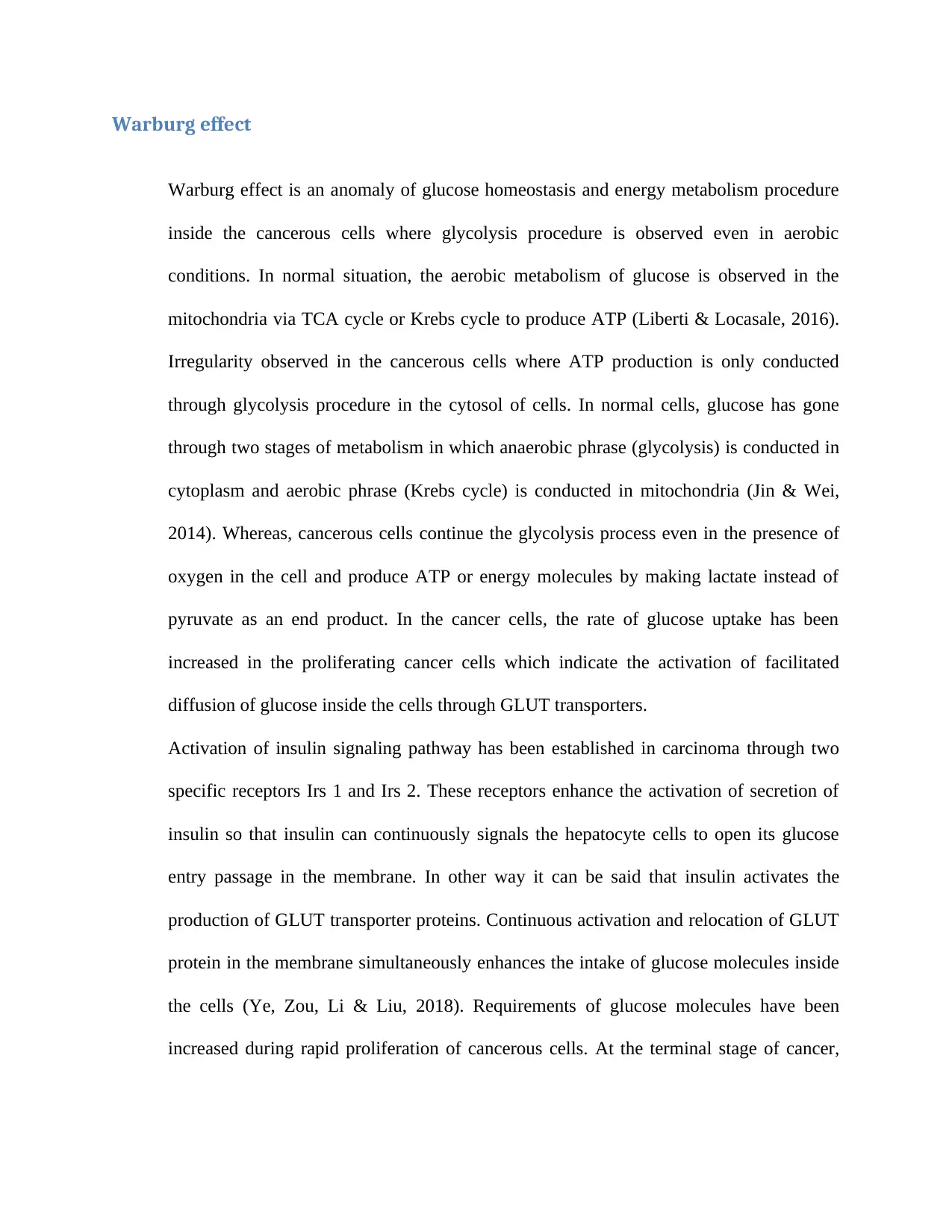
Warburg effect
Warburg effect is an anomaly of glucose homeostasis and energy metabolism procedure
inside the cancerous cells where glycolysis procedure is observed even in aerobic
conditions. In normal situation, the aerobic metabolism of glucose is observed in the
mitochondria via TCA cycle or Krebs cycle to produce ATP (Liberti & Locasale, 2016).
Irregularity observed in the cancerous cells where ATP production is only conducted
through glycolysis procedure in the cytosol of cells. In normal cells, glucose has gone
through two stages of metabolism in which anaerobic phrase (glycolysis) is conducted in
cytoplasm and aerobic phrase (Krebs cycle) is conducted in mitochondria (Jin & Wei,
2014). Whereas, cancerous cells continue the glycolysis process even in the presence of
oxygen in the cell and produce ATP or energy molecules by making lactate instead of
pyruvate as an end product. In the cancer cells, the rate of glucose uptake has been
increased in the proliferating cancer cells which indicate the activation of facilitated
diffusion of glucose inside the cells through GLUT transporters.
Activation of insulin signaling pathway has been established in carcinoma through two
specific receptors Irs 1 and Irs 2. These receptors enhance the activation of secretion of
insulin so that insulin can continuously signals the hepatocyte cells to open its glucose
entry passage in the membrane. In other way it can be said that insulin activates the
production of GLUT transporter proteins. Continuous activation and relocation of GLUT
protein in the membrane simultaneously enhances the intake of glucose molecules inside
the cells (Ye, Zou, Li & Liu, 2018). Requirements of glucose molecules have been
increased during rapid proliferation of cancerous cells. At the terminal stage of cancer,
Warburg effect is an anomaly of glucose homeostasis and energy metabolism procedure
inside the cancerous cells where glycolysis procedure is observed even in aerobic
conditions. In normal situation, the aerobic metabolism of glucose is observed in the
mitochondria via TCA cycle or Krebs cycle to produce ATP (Liberti & Locasale, 2016).
Irregularity observed in the cancerous cells where ATP production is only conducted
through glycolysis procedure in the cytosol of cells. In normal cells, glucose has gone
through two stages of metabolism in which anaerobic phrase (glycolysis) is conducted in
cytoplasm and aerobic phrase (Krebs cycle) is conducted in mitochondria (Jin & Wei,
2014). Whereas, cancerous cells continue the glycolysis process even in the presence of
oxygen in the cell and produce ATP or energy molecules by making lactate instead of
pyruvate as an end product. In the cancer cells, the rate of glucose uptake has been
increased in the proliferating cancer cells which indicate the activation of facilitated
diffusion of glucose inside the cells through GLUT transporters.
Activation of insulin signaling pathway has been established in carcinoma through two
specific receptors Irs 1 and Irs 2. These receptors enhance the activation of secretion of
insulin so that insulin can continuously signals the hepatocyte cells to open its glucose
entry passage in the membrane. In other way it can be said that insulin activates the
production of GLUT transporter proteins. Continuous activation and relocation of GLUT
protein in the membrane simultaneously enhances the intake of glucose molecules inside
the cells (Ye, Zou, Li & Liu, 2018). Requirements of glucose molecules have been
increased during rapid proliferation of cancerous cells. At the terminal stage of cancer,
⊘ This is a preview!⊘
Do you want full access?
Subscribe today to unlock all pages.

Trusted by 1+ million students worldwide
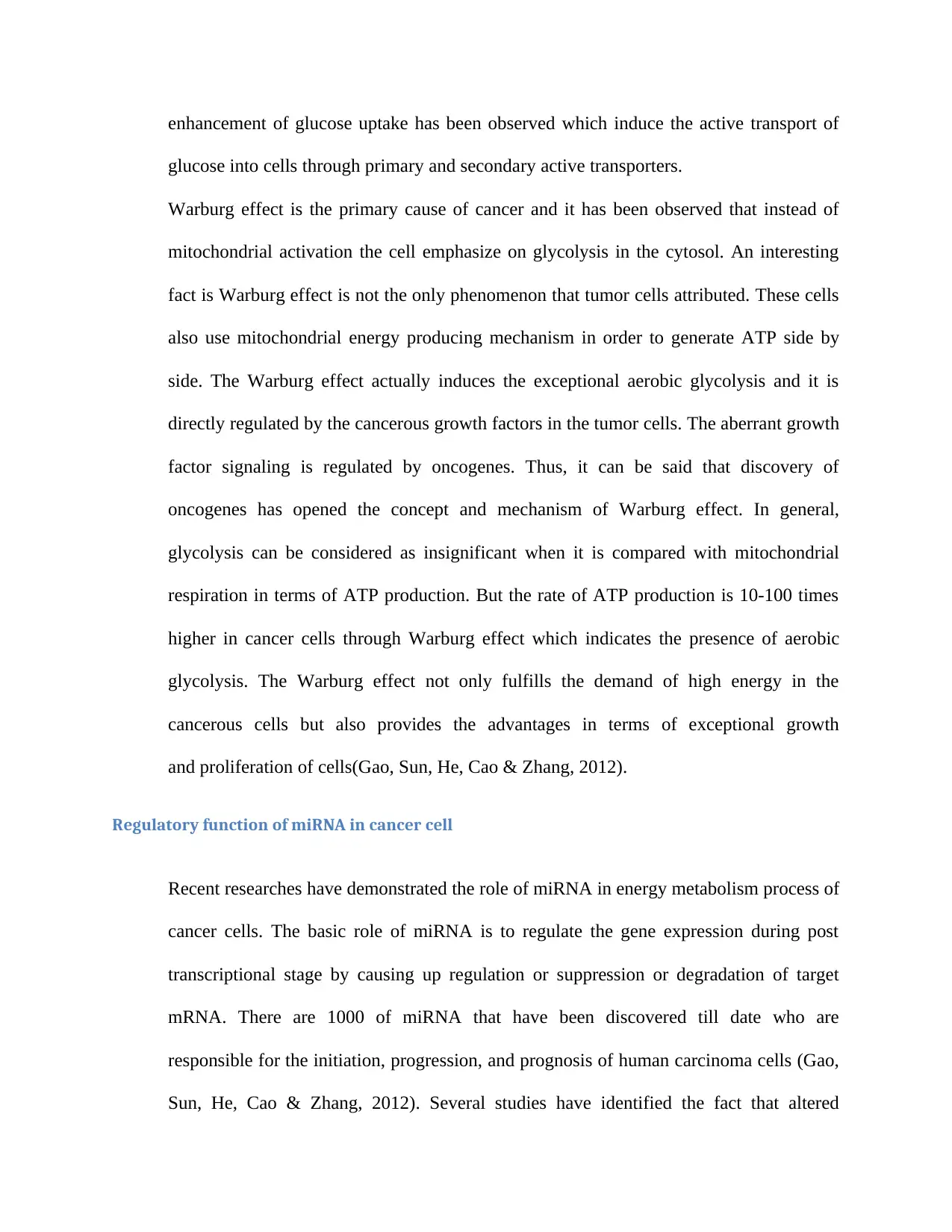
enhancement of glucose uptake has been observed which induce the active transport of
glucose into cells through primary and secondary active transporters.
Warburg effect is the primary cause of cancer and it has been observed that instead of
mitochondrial activation the cell emphasize on glycolysis in the cytosol. An interesting
fact is Warburg effect is not the only phenomenon that tumor cells attributed. These cells
also use mitochondrial energy producing mechanism in order to generate ATP side by
side. The Warburg effect actually induces the exceptional aerobic glycolysis and it is
directly regulated by the cancerous growth factors in the tumor cells. The aberrant growth
factor signaling is regulated by oncogenes. Thus, it can be said that discovery of
oncogenes has opened the concept and mechanism of Warburg effect. In general,
glycolysis can be considered as insignificant when it is compared with mitochondrial
respiration in terms of ATP production. But the rate of ATP production is 10-100 times
higher in cancer cells through Warburg effect which indicates the presence of aerobic
glycolysis. The Warburg effect not only fulfills the demand of high energy in the
cancerous cells but also provides the advantages in terms of exceptional growth
and proliferation of cells(Gao, Sun, He, Cao & Zhang, 2012).
Regulatory function of miRNA in cancer cell
Recent researches have demonstrated the role of miRNA in energy metabolism process of
cancer cells. The basic role of miRNA is to regulate the gene expression during post
transcriptional stage by causing up regulation or suppression or degradation of target
mRNA. There are 1000 of miRNA that have been discovered till date who are
responsible for the initiation, progression, and prognosis of human carcinoma cells (Gao,
Sun, He, Cao & Zhang, 2012). Several studies have identified the fact that altered
glucose into cells through primary and secondary active transporters.
Warburg effect is the primary cause of cancer and it has been observed that instead of
mitochondrial activation the cell emphasize on glycolysis in the cytosol. An interesting
fact is Warburg effect is not the only phenomenon that tumor cells attributed. These cells
also use mitochondrial energy producing mechanism in order to generate ATP side by
side. The Warburg effect actually induces the exceptional aerobic glycolysis and it is
directly regulated by the cancerous growth factors in the tumor cells. The aberrant growth
factor signaling is regulated by oncogenes. Thus, it can be said that discovery of
oncogenes has opened the concept and mechanism of Warburg effect. In general,
glycolysis can be considered as insignificant when it is compared with mitochondrial
respiration in terms of ATP production. But the rate of ATP production is 10-100 times
higher in cancer cells through Warburg effect which indicates the presence of aerobic
glycolysis. The Warburg effect not only fulfills the demand of high energy in the
cancerous cells but also provides the advantages in terms of exceptional growth
and proliferation of cells(Gao, Sun, He, Cao & Zhang, 2012).
Regulatory function of miRNA in cancer cell
Recent researches have demonstrated the role of miRNA in energy metabolism process of
cancer cells. The basic role of miRNA is to regulate the gene expression during post
transcriptional stage by causing up regulation or suppression or degradation of target
mRNA. There are 1000 of miRNA that have been discovered till date who are
responsible for the initiation, progression, and prognosis of human carcinoma cells (Gao,
Sun, He, Cao & Zhang, 2012). Several studies have identified the fact that altered
Paraphrase This Document
Need a fresh take? Get an instant paraphrase of this document with our AI Paraphraser
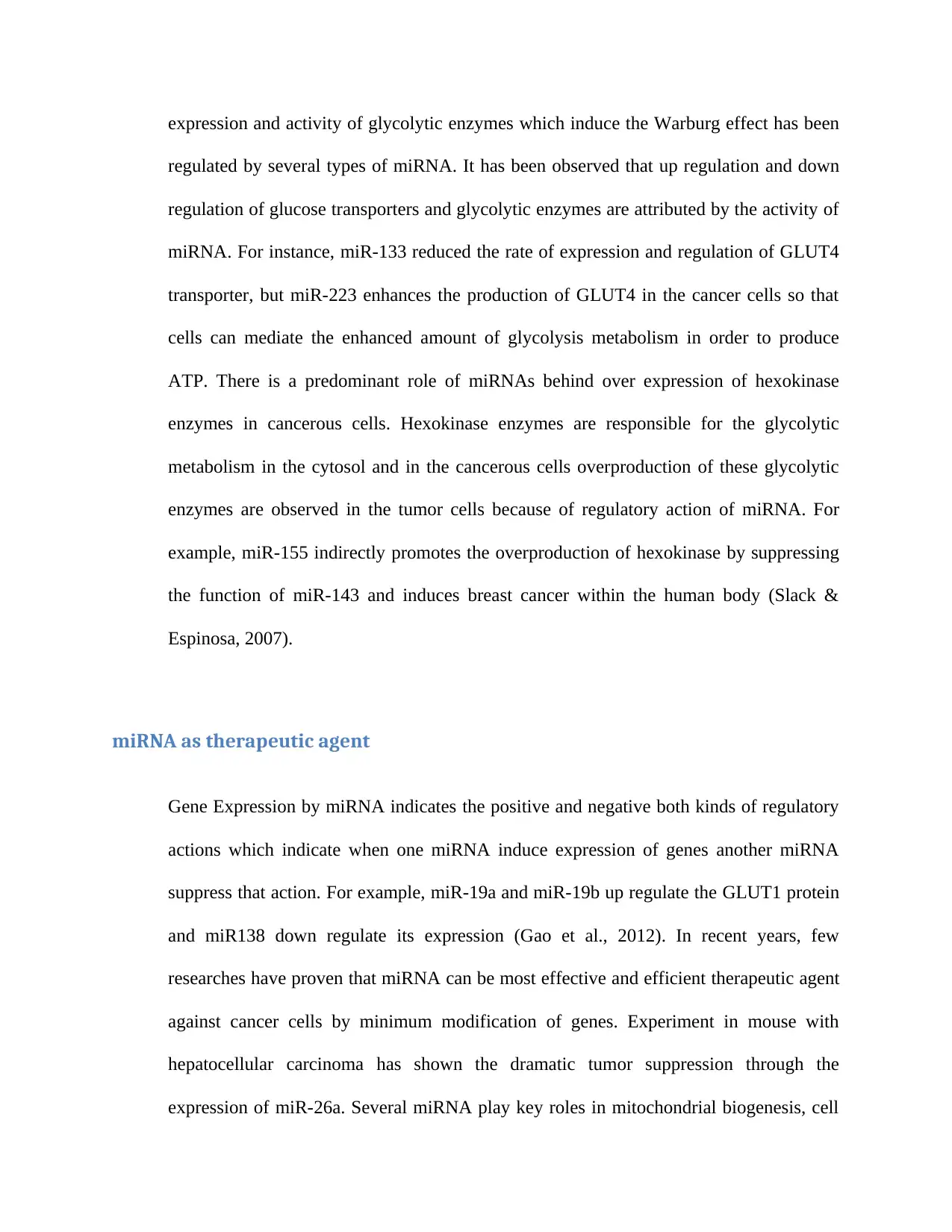
expression and activity of glycolytic enzymes which induce the Warburg effect has been
regulated by several types of miRNA. It has been observed that up regulation and down
regulation of glucose transporters and glycolytic enzymes are attributed by the activity of
miRNA. For instance, miR-133 reduced the rate of expression and regulation of GLUT4
transporter, but miR-223 enhances the production of GLUT4 in the cancer cells so that
cells can mediate the enhanced amount of glycolysis metabolism in order to produce
ATP. There is a predominant role of miRNAs behind over expression of hexokinase
enzymes in cancerous cells. Hexokinase enzymes are responsible for the glycolytic
metabolism in the cytosol and in the cancerous cells overproduction of these glycolytic
enzymes are observed in the tumor cells because of regulatory action of miRNA. For
example, miR-155 indirectly promotes the overproduction of hexokinase by suppressing
the function of miR-143 and induces breast cancer within the human body (Slack &
Espinosa, 2007).
miRNA as therapeutic agent
Gene Expression by miRNA indicates the positive and negative both kinds of regulatory
actions which indicate when one miRNA induce expression of genes another miRNA
suppress that action. For example, miR-19a and miR-19b up regulate the GLUT1 protein
and miR138 down regulate its expression (Gao et al., 2012). In recent years, few
researches have proven that miRNA can be most effective and efficient therapeutic agent
against cancer cells by minimum modification of genes. Experiment in mouse with
hepatocellular carcinoma has shown the dramatic tumor suppression through the
expression of miR-26a. Several miRNA play key roles in mitochondrial biogenesis, cell
regulated by several types of miRNA. It has been observed that up regulation and down
regulation of glucose transporters and glycolytic enzymes are attributed by the activity of
miRNA. For instance, miR-133 reduced the rate of expression and regulation of GLUT4
transporter, but miR-223 enhances the production of GLUT4 in the cancer cells so that
cells can mediate the enhanced amount of glycolysis metabolism in order to produce
ATP. There is a predominant role of miRNAs behind over expression of hexokinase
enzymes in cancerous cells. Hexokinase enzymes are responsible for the glycolytic
metabolism in the cytosol and in the cancerous cells overproduction of these glycolytic
enzymes are observed in the tumor cells because of regulatory action of miRNA. For
example, miR-155 indirectly promotes the overproduction of hexokinase by suppressing
the function of miR-143 and induces breast cancer within the human body (Slack &
Espinosa, 2007).
miRNA as therapeutic agent
Gene Expression by miRNA indicates the positive and negative both kinds of regulatory
actions which indicate when one miRNA induce expression of genes another miRNA
suppress that action. For example, miR-19a and miR-19b up regulate the GLUT1 protein
and miR138 down regulate its expression (Gao et al., 2012). In recent years, few
researches have proven that miRNA can be most effective and efficient therapeutic agent
against cancer cells by minimum modification of genes. Experiment in mouse with
hepatocellular carcinoma has shown the dramatic tumor suppression through the
expression of miR-26a. Several miRNA play key roles in mitochondrial biogenesis, cell
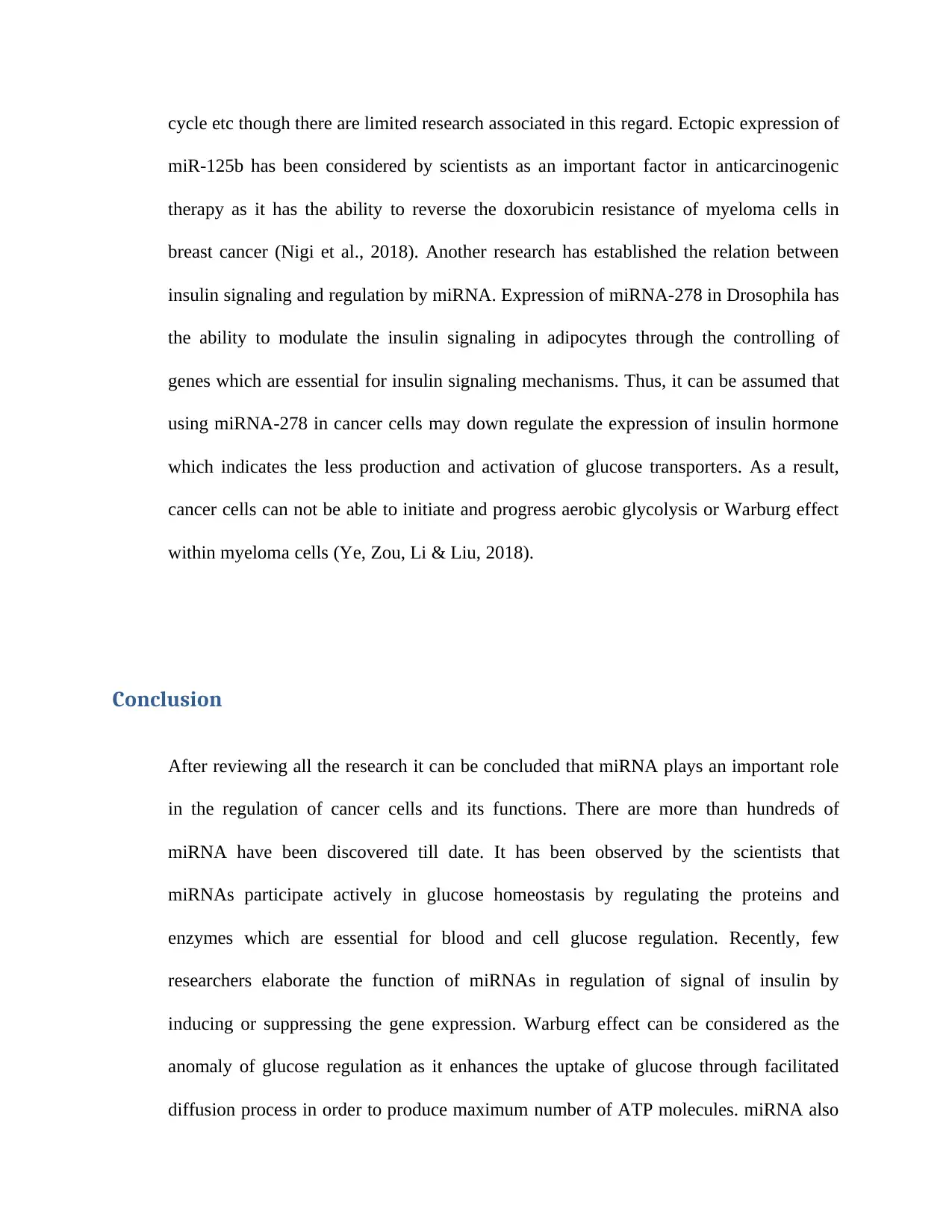
cycle etc though there are limited research associated in this regard. Ectopic expression of
miR-125b has been considered by scientists as an important factor in anticarcinogenic
therapy as it has the ability to reverse the doxorubicin resistance of myeloma cells in
breast cancer (Nigi et al., 2018). Another research has established the relation between
insulin signaling and regulation by miRNA. Expression of miRNA-278 in Drosophila has
the ability to modulate the insulin signaling in adipocytes through the controlling of
genes which are essential for insulin signaling mechanisms. Thus, it can be assumed that
using miRNA-278 in cancer cells may down regulate the expression of insulin hormone
which indicates the less production and activation of glucose transporters. As a result,
cancer cells can not be able to initiate and progress aerobic glycolysis or Warburg effect
within myeloma cells (Ye, Zou, Li & Liu, 2018).
Conclusion
After reviewing all the research it can be concluded that miRNA plays an important role
in the regulation of cancer cells and its functions. There are more than hundreds of
miRNA have been discovered till date. It has been observed by the scientists that
miRNAs participate actively in glucose homeostasis by regulating the proteins and
enzymes which are essential for blood and cell glucose regulation. Recently, few
researchers elaborate the function of miRNAs in regulation of signal of insulin by
inducing or suppressing the gene expression. Warburg effect can be considered as the
anomaly of glucose regulation as it enhances the uptake of glucose through facilitated
diffusion process in order to produce maximum number of ATP molecules. miRNA also
miR-125b has been considered by scientists as an important factor in anticarcinogenic
therapy as it has the ability to reverse the doxorubicin resistance of myeloma cells in
breast cancer (Nigi et al., 2018). Another research has established the relation between
insulin signaling and regulation by miRNA. Expression of miRNA-278 in Drosophila has
the ability to modulate the insulin signaling in adipocytes through the controlling of
genes which are essential for insulin signaling mechanisms. Thus, it can be assumed that
using miRNA-278 in cancer cells may down regulate the expression of insulin hormone
which indicates the less production and activation of glucose transporters. As a result,
cancer cells can not be able to initiate and progress aerobic glycolysis or Warburg effect
within myeloma cells (Ye, Zou, Li & Liu, 2018).
Conclusion
After reviewing all the research it can be concluded that miRNA plays an important role
in the regulation of cancer cells and its functions. There are more than hundreds of
miRNA have been discovered till date. It has been observed by the scientists that
miRNAs participate actively in glucose homeostasis by regulating the proteins and
enzymes which are essential for blood and cell glucose regulation. Recently, few
researchers elaborate the function of miRNAs in regulation of signal of insulin by
inducing or suppressing the gene expression. Warburg effect can be considered as the
anomaly of glucose regulation as it enhances the uptake of glucose through facilitated
diffusion process in order to produce maximum number of ATP molecules. miRNA also
⊘ This is a preview!⊘
Do you want full access?
Subscribe today to unlock all pages.

Trusted by 1+ million students worldwide

plays a key role in Warburg effect and induce the cancer proliferation process. There are
some other miRNAs which inhibit cancer cell proliferation by suppressing the necessary
tumor genes expression. Hence, it can be concluded that vast research need to be carried
out in upcoming years to identify the proper mechanism of miRNA in cancer disease.
This may helps to invent more therapeutic agents against cancer cells.
some other miRNAs which inhibit cancer cell proliferation by suppressing the necessary
tumor genes expression. Hence, it can be concluded that vast research need to be carried
out in upcoming years to identify the proper mechanism of miRNA in cancer disease.
This may helps to invent more therapeutic agents against cancer cells.
Paraphrase This Document
Need a fresh take? Get an instant paraphrase of this document with our AI Paraphraser
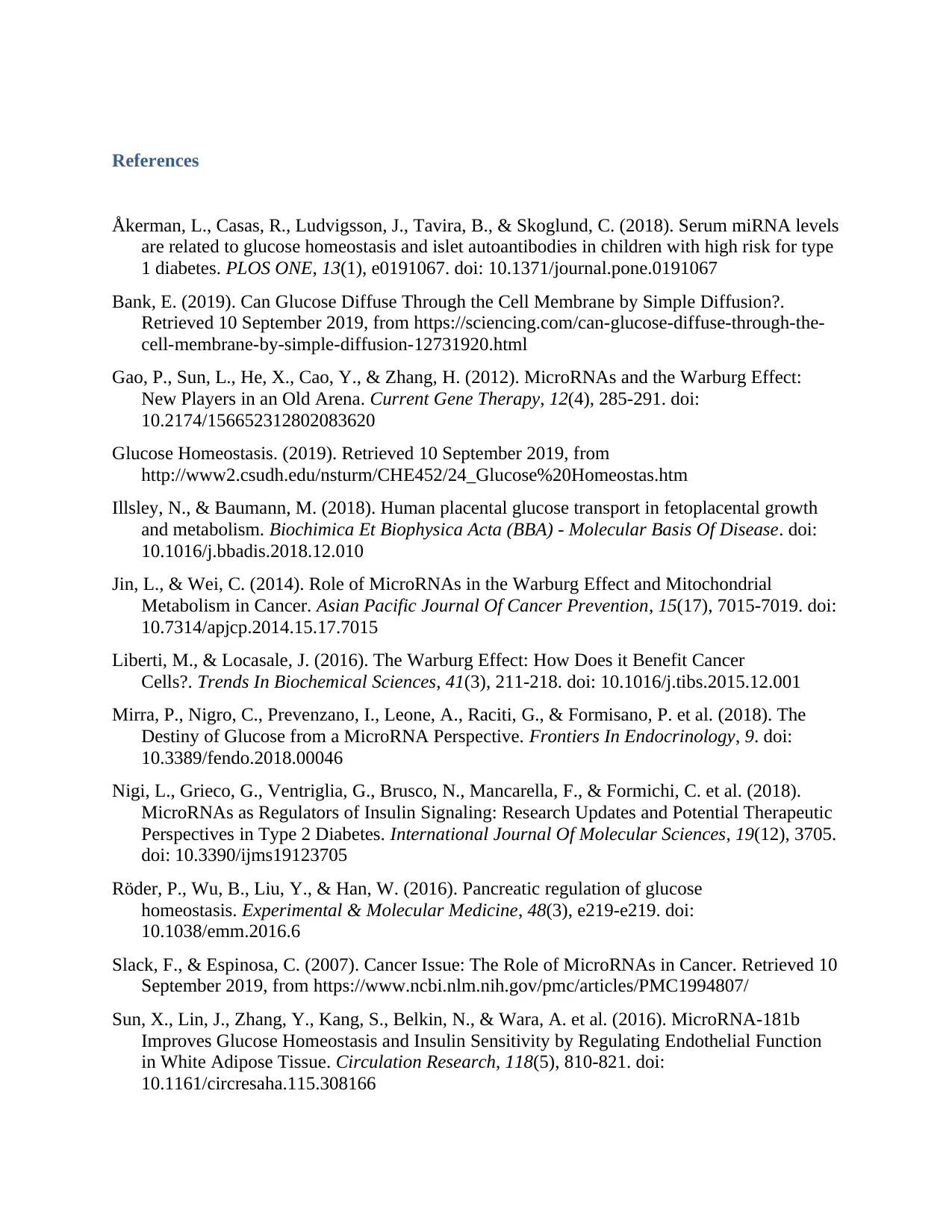
References
Åkerman, L., Casas, R., Ludvigsson, J., Tavira, B., & Skoglund, C. (2018). Serum miRNA levels
are related to glucose homeostasis and islet autoantibodies in children with high risk for type
1 diabetes. PLOS ONE, 13(1), e0191067. doi: 10.1371/journal.pone.0191067
Bank, E. (2019). Can Glucose Diffuse Through the Cell Membrane by Simple Diffusion?.
Retrieved 10 September 2019, from https://sciencing.com/can-glucose-diffuse-through-the-
cell-membrane-by-simple-diffusion-12731920.html
Gao, P., Sun, L., He, X., Cao, Y., & Zhang, H. (2012). MicroRNAs and the Warburg Effect:
New Players in an Old Arena. Current Gene Therapy, 12(4), 285-291. doi:
10.2174/156652312802083620
Glucose Homeostasis. (2019). Retrieved 10 September 2019, from
http://www2.csudh.edu/nsturm/CHE452/24_Glucose%20Homeostas.htm
Illsley, N., & Baumann, M. (2018). Human placental glucose transport in fetoplacental growth
and metabolism. Biochimica Et Biophysica Acta (BBA) - Molecular Basis Of Disease. doi:
10.1016/j.bbadis.2018.12.010
Jin, L., & Wei, C. (2014). Role of MicroRNAs in the Warburg Effect and Mitochondrial
Metabolism in Cancer. Asian Pacific Journal Of Cancer Prevention, 15(17), 7015-7019. doi:
10.7314/apjcp.2014.15.17.7015
Liberti, M., & Locasale, J. (2016). The Warburg Effect: How Does it Benefit Cancer
Cells?. Trends In Biochemical Sciences, 41(3), 211-218. doi: 10.1016/j.tibs.2015.12.001
Mirra, P., Nigro, C., Prevenzano, I., Leone, A., Raciti, G., & Formisano, P. et al. (2018). The
Destiny of Glucose from a MicroRNA Perspective. Frontiers In Endocrinology, 9. doi:
10.3389/fendo.2018.00046
Nigi, L., Grieco, G., Ventriglia, G., Brusco, N., Mancarella, F., & Formichi, C. et al. (2018).
MicroRNAs as Regulators of Insulin Signaling: Research Updates and Potential Therapeutic
Perspectives in Type 2 Diabetes. International Journal Of Molecular Sciences, 19(12), 3705.
doi: 10.3390/ijms19123705
Röder, P., Wu, B., Liu, Y., & Han, W. (2016). Pancreatic regulation of glucose
homeostasis. Experimental & Molecular Medicine, 48(3), e219-e219. doi:
10.1038/emm.2016.6
Slack, F., & Espinosa, C. (2007). Cancer Issue: The Role of MicroRNAs in Cancer. Retrieved 10
September 2019, from https://www.ncbi.nlm.nih.gov/pmc/articles/PMC1994807/
Sun, X., Lin, J., Zhang, Y., Kang, S., Belkin, N., & Wara, A. et al. (2016). MicroRNA-181b
Improves Glucose Homeostasis and Insulin Sensitivity by Regulating Endothelial Function
in White Adipose Tissue. Circulation Research, 118(5), 810-821. doi:
10.1161/circresaha.115.308166
Åkerman, L., Casas, R., Ludvigsson, J., Tavira, B., & Skoglund, C. (2018). Serum miRNA levels
are related to glucose homeostasis and islet autoantibodies in children with high risk for type
1 diabetes. PLOS ONE, 13(1), e0191067. doi: 10.1371/journal.pone.0191067
Bank, E. (2019). Can Glucose Diffuse Through the Cell Membrane by Simple Diffusion?.
Retrieved 10 September 2019, from https://sciencing.com/can-glucose-diffuse-through-the-
cell-membrane-by-simple-diffusion-12731920.html
Gao, P., Sun, L., He, X., Cao, Y., & Zhang, H. (2012). MicroRNAs and the Warburg Effect:
New Players in an Old Arena. Current Gene Therapy, 12(4), 285-291. doi:
10.2174/156652312802083620
Glucose Homeostasis. (2019). Retrieved 10 September 2019, from
http://www2.csudh.edu/nsturm/CHE452/24_Glucose%20Homeostas.htm
Illsley, N., & Baumann, M. (2018). Human placental glucose transport in fetoplacental growth
and metabolism. Biochimica Et Biophysica Acta (BBA) - Molecular Basis Of Disease. doi:
10.1016/j.bbadis.2018.12.010
Jin, L., & Wei, C. (2014). Role of MicroRNAs in the Warburg Effect and Mitochondrial
Metabolism in Cancer. Asian Pacific Journal Of Cancer Prevention, 15(17), 7015-7019. doi:
10.7314/apjcp.2014.15.17.7015
Liberti, M., & Locasale, J. (2016). The Warburg Effect: How Does it Benefit Cancer
Cells?. Trends In Biochemical Sciences, 41(3), 211-218. doi: 10.1016/j.tibs.2015.12.001
Mirra, P., Nigro, C., Prevenzano, I., Leone, A., Raciti, G., & Formisano, P. et al. (2018). The
Destiny of Glucose from a MicroRNA Perspective. Frontiers In Endocrinology, 9. doi:
10.3389/fendo.2018.00046
Nigi, L., Grieco, G., Ventriglia, G., Brusco, N., Mancarella, F., & Formichi, C. et al. (2018).
MicroRNAs as Regulators of Insulin Signaling: Research Updates and Potential Therapeutic
Perspectives in Type 2 Diabetes. International Journal Of Molecular Sciences, 19(12), 3705.
doi: 10.3390/ijms19123705
Röder, P., Wu, B., Liu, Y., & Han, W. (2016). Pancreatic regulation of glucose
homeostasis. Experimental & Molecular Medicine, 48(3), e219-e219. doi:
10.1038/emm.2016.6
Slack, F., & Espinosa, C. (2007). Cancer Issue: The Role of MicroRNAs in Cancer. Retrieved 10
September 2019, from https://www.ncbi.nlm.nih.gov/pmc/articles/PMC1994807/
Sun, X., Lin, J., Zhang, Y., Kang, S., Belkin, N., & Wara, A. et al. (2016). MicroRNA-181b
Improves Glucose Homeostasis and Insulin Sensitivity by Regulating Endothelial Function
in White Adipose Tissue. Circulation Research, 118(5), 810-821. doi:
10.1161/circresaha.115.308166

Ye, J., Zou, M., Li, P., & Liu, H. (2018). MicroRNA Regulation of Energy Metabolism to Induce
Chemoresistance in Cancers. Technology In Cancer Research & Treatment, 17,
153303381880599. doi: 10.1177/1533033818805997
Chemoresistance in Cancers. Technology In Cancer Research & Treatment, 17,
153303381880599. doi: 10.1177/1533033818805997
⊘ This is a preview!⊘
Do you want full access?
Subscribe today to unlock all pages.

Trusted by 1+ million students worldwide
1 out of 12
Related Documents
Your All-in-One AI-Powered Toolkit for Academic Success.
+13062052269
info@desklib.com
Available 24*7 on WhatsApp / Email
![[object Object]](/_next/static/media/star-bottom.7253800d.svg)
Unlock your academic potential
Copyright © 2020–2025 A2Z Services. All Rights Reserved. Developed and managed by ZUCOL.





